 | |
| Location | Daugavas 38 |
|---|---|
| Capacity | 3,480 [1] |
| Surface | grass |
| Opened | 2008 |
| Closed | 2014 |
| Tenants | |
| Daugava Daugavpils | |
The Daugava Stadions was a football stadium in the city of Daugavpils, Latvia.
 | |
| Location | Daugavas 38 |
|---|---|
| Capacity | 3,480 [1] |
| Surface | grass |
| Opened | 2008 |
| Closed | 2014 |
| Tenants | |
| Daugava Daugavpils | |
The Daugava Stadions was a football stadium in the city of Daugavpils, Latvia.
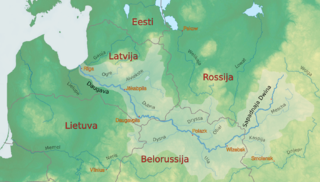
Daugava or Western Dvina is a large river rising in the Valdai Hills of Russia that flows through Belarus then Latvia into the Gulf of Riga of the Baltic Sea. It rises close to the source of the Volga. Its length is 1,020 km, of which 325 km are in Russia. It is a westward-flowing river, tracing out a great curve towards its south which means it passes through northern Belarus.
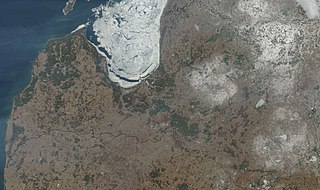
Latvia lies on the eastern shores of the Baltic Sea on the level northwestern part of the rising East European platform, between Estonia and Lithuania. About 98% of the country lies under 200 m (656 ft) elevation. With the exception of the coastal plains, the ice age divided Latvia into three main regions: the morainic Western and Eastern uplands and the Middle lowlands. Latvia holds over 12,000 rivers, only 17 of which are longer than 100 km (60 mi), and over 3,000 small lakes, most of which are eutrophic. The major rivers include the Daugava, the Lielupe, the Gauja, the Venta and the Salaca. Woodlands cover around 52% of the country. Other than peat, dolomite, and limestone, natural resources are scarce. Latvia has 531 km (330 mi) of sandy coastline, and the ports of Liepāja and Ventspils provide important warm-water harbors for the Baltic coast.
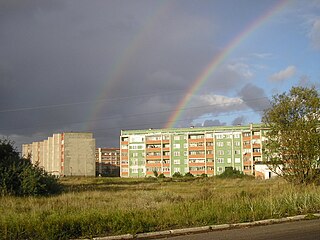
Bolderāja is a neighbourhood of Riga, the capital of Latvia. It is located on the left bank of the Daugava River, in Kurzeme District. Bolderāja probably began as a fishing village. The area has been inhabited since at least the 10th century and possibly for a longer period, however there is no firm evidence because of variations in the course of the Daugava River and the shifting of sand dunes.
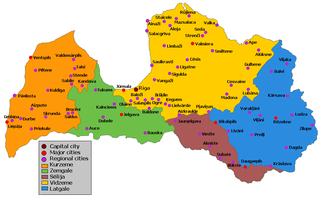
Selonia, also known as Augšzeme, is one of the Historical Latvian Lands encompassing the eastern part of the historical region of Semigallia as well as a portion of northeastern Lithuania. Its main city and cultural center is Jēkabpils. The Selonian language has become extinct, though some of the inhabitants still speak a Latgalian dialect.
Celtnieks Stadium is a multi-purpose stadium in Daugavpils, Latvia. It is currently used mostly for football matches and is the home stadium of FC Daugava. The stadium has capacity for 1,980 people.

Daugava National Stadium is a multifunctional stadium in Riga, Latvia, which was first opened in 1927. It holds football and athletics competitions. Since 1992 the Daugava Stadium has been designated as a sports facility of national importance and is owned by the Government of Latvia.
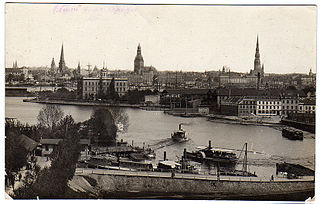
Pārdaugava is an area most often associated with Riga, composed of several neighbourhoods on the west (left) bank of Daugava River. The name is literally translated as 'over Daugava'.

Sarkandaugava is a neighbourhood of Riga, Latvia.

Daugavpils District was an administrative division of Latvia, located in Latgale region, in the country's south-east. It was organized into two cities and twenty one parishes, each with a local government authority. The district council headquarters were located in the city of Daugavpils, which, however, was not part of the district.

Ķīpsala is an island on the left bank of the Daugava river, connected to Riga city center and Pārdaugava by the Shroud Bridge. Ķīpsala is divided from the rest of Riga by the Daugava in the east, Roņu dīķis in the north, Zunda in the west and Agenskalna līcis in the south.
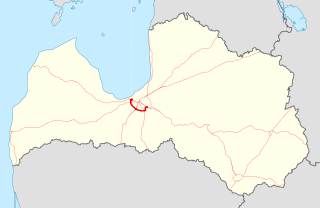
The A5 is a national road in Latvia which is part beltway around Riga, connecting Salaspils to Babīte. The road is also known as Riga bypass. The road is part of European route E67, European route E77 and Latvian TEN-T road network. The length of A5 is 41 kilometer. Currently A5 has 1x1 lanes until interchange with A9 then it turns to 2x2 all the way until Babīte. Most of the traffic on A5 is made up by trucks. A5 crosses river Daugava on Riga HES, and the A5 part on the HES has been reconstructed in 2010/2011. Another part of A5 between A8 and A9 was reconstructed in 2011. There are plans to build a new bridge over Daugava opposite to the end of A4, in further future. Current speed limit is 90 km/h. The average AADT of A5 in 2016 was 12 482 cars per day.
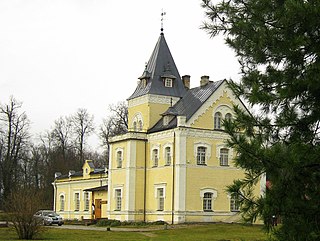
Dole Manor is a manor house on Dole Island in the Daugava River, in the historical region of Vidzeme, in central Latvia, not far from Riga.
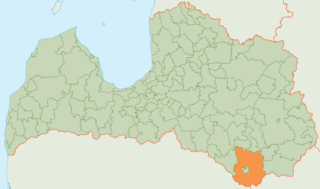
Daugavpils Municipality was a municipality in Latgale, Latvia from 2009 to 2021.

Lucavsala is an island located on the Daugava River in Riga, Latvia. It has a population of 98.
The 2014–15 Latvian Football Cup is the twentieth season of the Latvian annual football knock-out competition. The winners will qualify for the first qualifying round of the 2015–16 UEFA Europa League.
The Belarus–Latvia border is of length 172.912 km (107.443 mi). In spans from the tripoint with Lithuania to the tripoint with Russia. It is an external border of the European Union.
Surazh is an urban-type settlement in Vitebsk Region of Belarus, approximately 45km northeast from the city of Vitebsk. It is situated at the crossing of the Daugava and Kasplya rivers.
The 1951 Soviet Cup was an association football cup competition of the Soviet Union.
UEFA Group D of the 2023 FIFA Women's World Cup qualification competition consists of six teams: England, Austria, Northern Ireland, North Macedonia, Latvia, and Luxembourg. The composition of the nine groups in the qualifying group stage was decided by the draw held on 30 April 2021, with the teams seeded according to their coefficient ranking.
Coordinates: 55°52′29″N26°33′02″E / 55.874637°N 26.550530°E